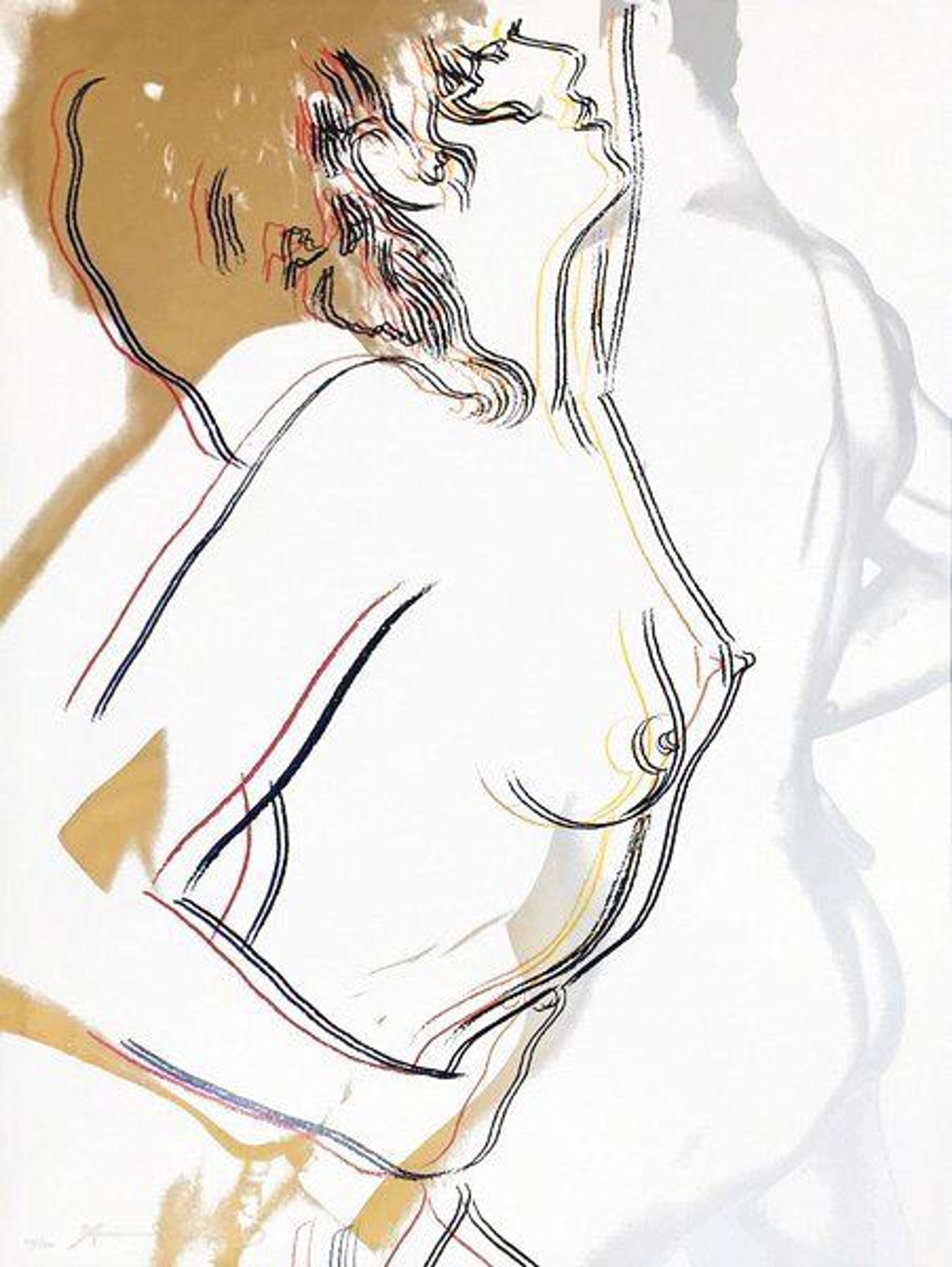 Love (F. & S. II.312) © Andy Warhol 1983
Love (F. & S. II.312) © Andy Warhol 1983
Interested in buying or selling
Andy Warhol?

Andy Warhol
487 works
In his Love series, Andy Warhol turned his attention away from the world of the fame and exclusivity, to focus on the universal experience of love. The prints are underscored by a sense of emptiness, which is coloured and filled by the embrace of the lovers alone. The intimate series is typical of Warhol's later oeuvre, and speaks to the romanticism that he usually shied away from.
The series champions love and desire.
 Love (F. & S. II.310) © Andy Warhol 1983
Love (F. & S. II.310) © Andy Warhol 1983Warhol's Love series depicts a couple embracing, illuminated by soft colour. Through his gestural graphic lines, Warhol pronounced the tender interaction between the couple. Though Warhol is best known for his portraits of the singular iconic celebrity, the Love series focuses on the union between two lovers and their desirous connection. Fame, wealth, and excess - all the defining characteristics of Warhol's oeuvre - are abandoned in this sensual series.
The Love prints are reminiscent of Warhol's early commercial illustrations.
 A Gold Book, Man With Rose (F. & S. IV.108) © Andy Warhol 1957
A Gold Book, Man With Rose (F. & S. IV.108) © Andy Warhol 1957With his simple graphic lines, the style of Warhol's Love series harks back to his early career. Working as a commercial illustrator when he moved to New York in the 1950s, Warhol developed a clearcut printing style which allowed for quick reproduction. This early style is best seen in his A Gold Book, Cats Named Sam and La Recherche Du Shoe Perdu series. Throughout his career and reign as the ’Prince of Pop’, Warhol continued to develop this flat style of representation, and the Love series presents the maturity of his approach.
Warhol focused on erotica elsewhere in his oeuvre.
 Sex Parts (F. & S. II.174) © Andy Warhol 1978
Sex Parts (F. & S. II.174) © Andy Warhol 1978Though Warhol's primary focus in the 1960s was the cult of celebrity and consumerism, the late 70s presented a new era of experimentation in his oeuvre. Increasingly, Warhol turned his attention to love, desire and erotica, which culminated with his Sex Parts series. However, this controversial series was merely the peak of his erotic artwork, as Warhol had been creating sexually-charged drawings and prints since the early days of his career.
Warhol had a preoccupation with love.
 A Gold Book, Hand With Carnation, (F. & S. IV.115) © Andy Warhol 1957
A Gold Book, Hand With Carnation, (F. & S. IV.115) © Andy Warhol 1957Though the theme of love might not have been overtly expressed by Warhol, at least not to the same extent as other Pop Artists like Keith Haring, love was integral to his life and career. In early print series, like A Gold Book, we see subtle allusions to love through universal symbolism. In his Love series of 1983, however, Warhol makes the love between his two subjects obvious through the title of the prints and the romantic embrace between them.
Warhol enveloped his embracing lovers in a sultry haze of colour.
 Love (F. & S. II.312) © Andy Warhol 1983
Love (F. & S. II.312) © Andy Warhol 1983With his predominant use of pink and yellow, especially in Love (F. & S. II.312) and Love (F. & S. II.311), Warhol heightened the sensuality binding the couple together. The colours, which appear to be sprayed at the bottom of the composition, seem to mingle with one another, and blend to symbolise the couple's union. This print series is distinct due to the unusual amount of white space left on the canvas, but the subtle colour has a moving effect on the embrace Warhol depicted.
The series plays with double exposure.
 Kiku (F. & S. II.309) © Andy Warhol 1983
Kiku (F. & S. II.309) © Andy Warhol 1983Particularly in Love (F. & S. II.310), Warhol treats his canvas almost like a photograph. In the foreground, his female sitter leans towards the centre of the composition, clutching her stomach. Her heavily outlined figure leads the viewer's eye towards the right of the composition, where the male's figure is lightly rendered in grey. This double exposure style reveals Warhol's occupation with photography, and his artful approach to layering during the printing process to create drama.
Warhol doesn't capture the gaze of his nude subjects.
 Love (F. & S. II.311) © Andy Warhol 1983
Love (F. & S. II.311) © Andy Warhol 1983Unlike his celebrity portraits, which usually capture the star-studded subject looking directly out to the viewer, the sitters in the Love series make eye contact only with each other. The aversion of the lovers' gaze heightens the voyeurism of these prints, and gives the impression that the viewer is intruding on an intimate moment between them.
The series is the romantic counterpart to his Sex Parts series.
 Sex Parts (F. & S. II.176) © Andy Warhol 1978
Sex Parts (F. & S. II.176) © Andy Warhol 1978Created five years after his explicit Sex Parts series, Love is a more naive approach to the subject of lust and sex. While Sex Parts focused on close-ups of male genitalia during sex, the Love prints depicted the passionate moments leading up to it.
The series is typical of Warhol's later style.
 Gems (F. & S. II.87) © Andy Warhol 1978
Gems (F. & S. II.87) © Andy Warhol 1978With his reduced palette and greater focus on graphic line, the Love series is typical of Warhol's later style. Warhol's later oeuvre is characterised by a larger amount of white space, and a turn away from the celebrity and consumerism as his primary subject matter.
This is a rare instance in which the identity of Warhol's sitters is irrelevant.
 Marilyn I Love Your Kiss Forever © Andy Warhol 1964
Marilyn I Love Your Kiss Forever © Andy Warhol 1964Unlike his Pop portraits of modern icons, like Marilyn Monroe, Liz Taylor and Mick Jagger, the identity of the lovers in this series is unimportant. In fact, Warhol's purposeful omission of their identities makes the lovers all the more relatable. The series champions the universal emotion and act of love above all else.
